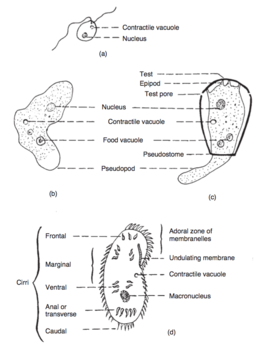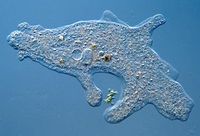Naked amoeba
Definition
A Naked Amoeba is a taxonomic classification of soil protozoa found in a variety of agricultural, grassland, and forested soils. These are the most voracious of all the soil protozoa and the most dominant in numbers, including a variety of species. Naked Amoeba, as well as other protozoans, exploit tiny microhabitats that are unavailable to other larger organisms, such as "Nematodes". Like other soil protozoa, they promote soil decomposition by enhancing bacterial metabolism, consuming excess bacteria, and excreting simple compounds utilized by plants.
Habitat
Movement & Anatomy

Differing from Testate Amoeba, which have a hard shell, Naked Amoeba do not. Amoeba do not have cell walls, allowing for free movement. Amoebae move and feed by using pseudopods, which are bulges of cytoplasm formed by the coordinated action of actin microfilaments pushing out the plasma membrane that surrounds the cell.
Dietary Processes
Naked Amoeba are phagotrophic, meaning they engulf the entirety of the organism in order to digest it. Phagocytosis involves the process of the amoeba extending its pseudopods and then creating a vacuole of the food within its cytoplasm, which it then digests using enzymes before releasing the processed material into the surrounding environment.

They can consume a variety of food sources, such as bacteria, fungi, algae, and other fine particulate matter in soils. A majority of bacteria consumed in soil is conducted by Naked Amoeba, as they are the most abundant and most efficient at decomposing bacteria. It is common for this variety of soil protozoa to be found in the rhizosphere due to the abundance of bacterial flora surrounding the plant root zones.
Reproduction
Naked Amoeba, as well as other soil protozoa, reproduce asexually via fission or via syngamy, which is the fusion of two cells.
References
Coleman, D. J., Callaham, M. A., Jr., & Crossley, D. A., Jr. (2018). Fundaments of Soil Ecology (Third ed.). Elsevier. <ref>Template:Cite book